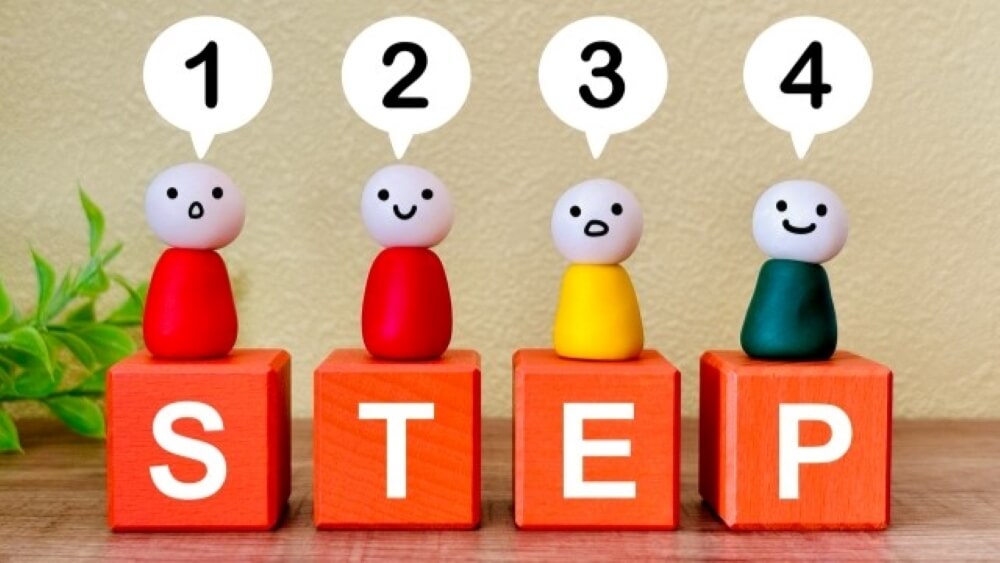Are you someone who wants to start learning Japanese, but has no idea where to start? For those who are learning Japanese for the first time, especially those who are not familiar with kanji characters, the journey may seem a bit challenging. However, by proceeding with learning step by step in the appropriate order, Japanese is by no means a difficult language to learn. In this article, we will outline effective steps for beginner Japanese learners to progress to a pre-intermediate level.
- Key Points for Effective Learning
- Japanese Learning Steps
- Step 1: Greetings and Basic Phrases
- Step 2: Hiragana and Katakana Reading
- Step 4: Learn Basic Grammar
- Step 5: Hiragana and Katakana Writing
- Step 6: First 50 Kanji Characters
- Step 7: Additional 700 Words
- Step 8: Practice Dictation
- Step 9: Practice Speaking with Natives
- Step 10: Another 100 Kanji Characters
- Step 11: Additional 500 Words
- Step 12: Learn Fundamental Grammar
- Step 13: Repeat Steps 8-11
Key Points for Effective Learning
Set Clear Goals and Schedule
Before embarking on your Japanese learning journey, clarify your learning goals. Goals vary from person to person, ranging from mastering everyday conversations to understanding Japanese anime and manga or achieving proficiency levels like JLPT N2. By setting clear goals, you can identify the specific efforts required and maintain your motivation throughout the learning process.
Additionally, it’s important to schedule your time to achieve your goals. Take a moment to assess how many hours per week you can commit to your studies. By doing so, you can visualize your progress and ensure that your schedule remains flexible, reducing the risk of giving up halfway through.
Start with Simpler Aspects
When beginning to learn a language, it’s crucial to start with simpler aspects. This approach boosts motivation and helps prevent frustration in the early stages. Japanese has relatively clear distinctions between easy and difficult aspects. For example, ‘keigo’ (honorific language) and ‘kanji’ are considered challenging, while ‘pronunciation’ and ‘basic grammar’ are relatively easy compared to other languages.
Furthermore, “hiragana” and “katakana,” which are Japanese characters, have fewer strokes and a limited number of characters compared to “kanji”, making them much easier to learn. Hiragana and Katakana are essential for reading texts and understanding correct Japanese pronunciation, so it’s important to learn them early on.
Choose the Right Learning Method by Stages
Choosing a learning method that suits your language level is crucial for effective Japanese learning. In the beginning stages, focus on input learning using textbooks and flashcards. Supplementing with language learning apps that offer a gamified approach can also be highly effective, especially if traditional methods become monotonous.
As you acquire basic knowledge, gradually incorporate output learning strategies into your routine. Practice using the grammar and vocabulary you’ve learned will significantly improve your Japanese language skills. Working with a Japanese tutor who can provide feedback and guidance is invaluable for refining your skills and addressing areas for improvement.
By completing all 13 steps outlined in this article, you’ll be well on your way to reaching an pre-intermediate level of Japanese proficiency. At this stage, challenge yourself by engaging with Japanese manga and anime. These resources offer opportunities to learn natural expressions and colloquial language. However, be mindful that some manga and anime may contain content that differs from real-life situations. For more guidance on selecting suitable material, refer to the article ‘Best Anime for Learning Japanese: From Beginners to Advanced.’
Japanese Learning Steps

To reach a pre-intermediate level (A2) in Japanese, you need to learn a certain amount of vocabulary, characters, and grammar. The order in which these factors are learned plays a important role in effective and efficient learning. Outlined below are the steps you need to take to progress from a complete beginner to a pre-intermediate level:
- Greetings and Basic Phrases
- Hiragana and Katakana Reading
- First 300 Words
- Basic Grammar
- Hiragana and Katakana Writing (*optional)
- First 50 Kanji Characters
- Additional 700 Words
- Dictation
- Speaking with Natives
- Another 100 Kanji Characters (*optional)
- Additional 500 Words
- Fundamental Grammar
- Repeat Steps 8-11
Estimated study hours to become A2 or JLPT N4 level, it will probably takes about 600 to 900 hours for people from non-kanji countries and 400-600 hours for people from kanji countries
Step 1: Greetings and Basic Phrases
As the first step in learning Japanese, begin by memorising common greetings and frequently used phrases. There are many basic phrases in Japanese that cannot be directly translated into other languages.
For example, phrases like “itadakimasu” before meals, “tadaima” upon returning home, and “otsukaresama” as a greeting among adults are deeply ingrained in Japanese culture, requiring rote memorisation. Learning ready-to-use phrases like these will make you feel like you can speak Japanese even a little bit, which is important when embarking on a new challenge.
Estimated Learning Time: 5 hours
Learning Materials:
Step 2: Hiragana and Katakana Reading
Learning hiragana and katakana is equivalent to learning the alphabet in English. In other words, it’s not an option but a mandatory subject, and it should be mastered as early as possible. Being able to read them is essential for getting the pronunciation right.
In Japanese writing, there are 46 hiragana characters and 46 katakana characters. Katakana is used for foreign words, onomatopoeia, and certain proper nouns. It’s best to start by understanding how to read them to ensure accurate pronunciation. Once you’re comfortable with that, you can work on writing them.
Estimated Learning Time: 20 hours
Learning Materials:
Step 3: First 300 Words
Start by memorising 300 basic words commonly used in everyday conversations. However, knowing just these 300 words isn’t enough for holding conversations. So, why 300 words? Well, it’s because this number strikes a balance—it’s not too overwhelming for beginners, yet it covers the vocabulary necessary for learning basic grammar.
A great way to memorising words is to pick up Kanshudo’s Word 1 to 300 list or the basic vocabulary list shown below and install them into Anki app. You don’t have to learn everything at once. By reviewing the same words repeatedly, you’ll gradually build them into your long-term memory. Anki is an excellent tool for learning vocabulary because it adjusts the timing of reviews based on the forgetting curve. While the iPhone version is paid, you can also use it for free on your PC, so be sure to give it a try!
It’s also important to check example sentences along with the words because they may not always be used with the same meaning as in your native language. Some people prefer learning words while learning grammar, however, the example sentences in grammar textbooks may not always incorporate frequently used words. As a result, this method may be inefficient.
Estimated Learning Time: 20 hours
Learning Materials:
- 100 Frequently Used Japanese Nouns to Learn First
- First 50 Japanese Verbs
- First 50 Japanese Adjectives
- Kanshudo: The most useful 10,000 words in Japanese
Step 4: Learn Basic Grammar
After acquiring a basic vocabulary, the next step is to learn basic grammar. Japanese grammar structure differs significantly from many other languages. You’ll need to grasp Japanese sentence structure and familiarise yourself with commonly used basic sentence patterns.
At this stage, being able to use the grammar required for JLPT N5 level is sufficient. Learning through apps like Duolingo can be fun and effective. Once you learn a new grammar structure, try creating sentences using the words you learned in Step 3 to reinforce your understanding.
Estimated Learning Time: 50 hours
Learning Materials:
Step 5: Hiragana and Katakana Writing
At this point, begin practicing writing hiragana and katakana. If your goal in learning Japanese is to have simple conversations with friends or family, you may not need to learn how to write characters. However, if you plan to live in Japan or gain a deep understanding of Japanese culture, knowing how to write characters is essential.
By now, you should already be familiar with reading hiragana and katakana, so learning to write them shouldn’t take too long. Utilise children’s workbooks or apps for writing practice, as they will help you develop balanced and accurate writing skills.
Estimated Learning Time: 20 hours
Learning Materials:
Step 6: First 50 Kanji Characters
Learning kanji can be both an enjoyable and the most challenging aspect of learning Japanese. Unlike hiragana and katakana, there are over 2,000 common kanji characters, which can sometimes demotivate learners. However, don’t worry! Even native speakers spend over 10 years gradually learning them. Moreover, many adults cannot write all 2,000 kanji characters correctly.
To begin, focusing on memorising the 50 most frequently used kanji characters is more than enough. The kanji you should prioritise learning initially have fewer strokes and are not so difficult. As a guideline, if you aim to learn 10 kanji in one hour, it will take approximately 5 hours to learn 50 kanji. Afterward, to solidify your knowledge by review and write all the kanji at least ten times.
Estimated Learning Time: 50 hours
Learning Materials:
Step 7: Additional 700 Words
While reviewing the 300 words you learned in Step 3, learn an additional 700 words, totaling 1,000 words in your vocabulary. Memorising 1,000 foreign language words is never an easy task. However, once you accomplish this step, you’ll have a better grasp of many commonly used words in daily life. This will enable you to understand what native speakers are saying and engage in basic conversations to express simple intentions.
Estimated Learning Time: 40 hours
Step 8: Practice Dictation
Practice exercises to review what you’ve learned so far. Specifically, listen to simple Japanese phrases and try to write down what you hear. Dictation not only improves your listening and writing skills but also helps review vocabulary and grammar. While it’s ideal to receive dictation exercises from a Japanese tutor who can monitor your progress, if that’s not possible, you can use websites and apps designed for dictation practice.
Learning Materials:
Step 9: Practice Speaking with Natives
To increase opportunities for outputting what you’ve learned, practice speaking with native speakers. You can find conversation partners who are native speakers on apps like HelloTalk or iTalki. However, if your budget allows, it’s best to find a professional tutor who can notice your mistakes and point out areas where you need improvement. Through conversation practice, you’ll solidify your understanding and acquire accurate pronunciation.
Learning Materials:
Step 10: Another 100 Kanji Characters
Once you start feeling somewhat comfortable with Japanese, it’s time to resume learning kanji. Since kanji practice can be quite challenging, it’s best to tackle them in chunks of around 100 characters while continuing conversation practice. If your goal involves writing in Japanese, make sure to practice both the readings and writings of the kanji.
Estimated Learning Time: 60 hours
Step 11: Additional 500 Words
As you study new words, don’t neglect reviewing the words you’ve previously learned.
Estimated Learning Time: 30 hours
Step 12: Learn Fundamental Grammar
To express precise nuances and form longer sentences, it’s important to learn fundamental grammar. Specifically, aim to grasp grammar concepts at the JLPT N4 level. Practice using newly learned structures to prevent them from slipping from memory.
Estimated Learning Time: 50 hours
Learning Materials:
Step 13: Repeat Steps 8-11
Keep practicing dictation and engaging in conversation while exposing yourself to a wider range of vocabulary. By the end of this stage, you should have acquired around 2000 words, 250-300 kanji characters, and gained knowledge of basic grammar. This level of knowledge will enable you to engage in simple daily conversations with ease.
Estimated Learning Time: 150-200 hours
By persistently following the above steps, reaching a pre-intermediate level in Japanese isn’t as challenging as it may seem. Once you reach this level, you’ll enjoy watching Japanese animation or reading manga, which will further enhance your Japanese proficiency.


